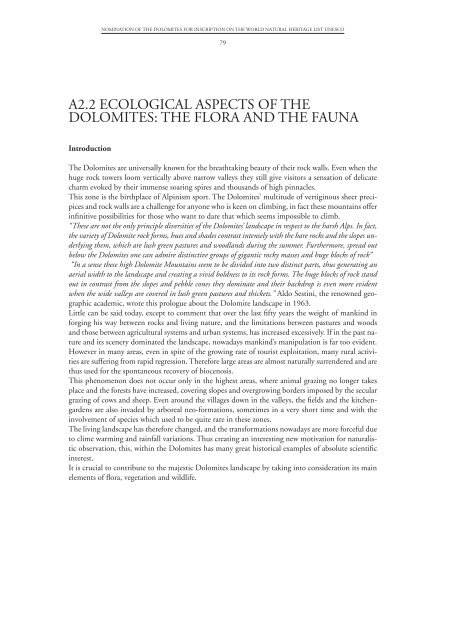DOLOMITES - Annexes 2-8 - Provincia di Udine
DOLOMITES - Annexes 2-8 - Provincia di Udine
DOLOMITES - Annexes 2-8 - Provincia di Udine
Create successful ePaper yourself
Turn your PDF publications into a flip-book with our unique Google optimized e-Paper software.
NOMINATION OF THE <strong>DOLOMITES</strong> FOR INSCRIPTION ON THE WORLD NATURAL HERITAGE LIST UNESCO<br />
A2.2 ECOLOGICAL ASPECTS OF THE<br />
<strong>DOLOMITES</strong>: THE FLORA AND THE FAUNA<br />
introduction<br />
79<br />
The Dolomites are universally known for the breathtaking beauty of their rock walls. Even when the<br />
huge rock towers loom vertically above narrow valleys they still give visitors a sensation of delicate<br />
charm evoked by their immense soaring spires and thousands of high pinnacles.<br />
This zone is the birthplace of Alpinism sport. The Dolomites’ multitude of vertiginous sheer precipices<br />
and rock walls are a challenge for anyone who is keen on climbing, in fact these mountains offer<br />
infinitive possibilities for those who want to dare that which seems impossible to climb.<br />
“These are not the only principle <strong>di</strong>versities of the Dolomites’ landscape in respect to the harsh Alps. In fact,<br />
the variety of Dolomite rock forms, hues and shades contrast intensely with the bare rocks and the slopes underlying<br />
them, which are lush green pastures and woodlands during the summer. Furthermore, spread out<br />
below the Dolomites one can admire <strong>di</strong>stinctive groups of gigantic rocky masses and huge blocks of rock”<br />
“In a sense these high Dolomite Mountains seem to be <strong>di</strong>vided into two <strong>di</strong>stinct parts, thus generating an<br />
aerial width to the landscape and creating a vivid boldness to its rock forms. The huge blocks of rock stand<br />
out in contrast from the slopes and pebble cones they dominate and their backdrop is even more evident<br />
when the wide valleys are covered in lush green pastures and thickets.” Aldo Sestini, the renowned geographic<br />
academic, wrote this prologue about the Dolomite landscape in 1963.<br />
Little can be said today, except to comment that over the last fifty years the weight of mankind in<br />
forging his way between rocks and living nature, and the limitations between pastures and woods<br />
and those between agricultural systems and urban systems, has increased excessively. If in the past nature<br />
and its scenery dominated the landscape, nowadays mankind’s manipulation is far too evident.<br />
However in many areas, even in spite of the growing rate of tourist exploitation, many rural activities<br />
are suffering from rapid regression. Therefore large areas are almost naturally surrendered and are<br />
thus used for the spontaneous recovery of biocenosis.<br />
This phenomenon does not occur only in the highest areas, where animal grazing no longer takes<br />
place and the forests have increased, covering slopes and overgrowing borders imposed by the secular<br />
grazing of cows and sheep. Even around the villages down in the valleys, the fields and the kitchengardens<br />
are also invaded by arboreal neo-formations, sometimes in a very short time and with the<br />
involvement of species which used to be quite rare in these zones.<br />
The living landscape has therefore changed, and the transformations nowadays are more forceful due<br />
to clime warming and rainfall variations. Thus creating an interesting new motivation for naturalistic<br />
observation, this, within the Dolomites has many great historical examples of absolute scientific<br />
interest.<br />
It is crucial to contribute to the majestic Dolomites landscape by taking into consideration its main<br />
elements of flora, vegetation and wildlife.

















